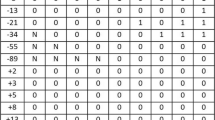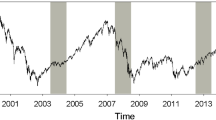Abstract
We propose a novel kernel-based trend pattern tracking (KTPT) system for portfolio optimization. It includes a three-state price prediction scheme, which extracts both of the following and reverting patterns from the asset price trend to make future price predictions. Moreover, KTPT is equipped with a novel kernel-based tracking system to optimize the portfolio, so as to capture a potential growth of the asset price effectively. The kernel measures the similarity between the current portfolio and the predicted price relative to control the influence of each asset when optimizing the portfolio, which is different from some previous kernels that measure the probability of occurrence of a price relative. Extensive experiments on 5 benchmark datasets from real-world stock markets with various assets in different time periods indicate that KTPT outperforms other state-of-the-art strategies in cumulative wealth and other risk-adjusted metrics, showing its effectiveness in portfolio optimization.









Similar content being viewed by others
References
Agarwal A, Hazan E, Kale S, Schapire RE (2006) Algorithms for portfolio management based on the Newton method. In: Proceedings of the 23rd international conference on machine learning
Algoet PH, Cover TM (1988) Asymptotic optimality and asymptotic equipartition properties of log-optimum investment. Ann Probab 16(2):876–898
Bertsekas D (1999) Nonlinear programming. Athena Scientific, Belmont
Blum A, Kalai A (1999) Universal portfolios with and without transaction costs. Mach Learn 35(3):193–205
Borodin A, El-Yaniv R, Gogan V (2004) Can we learn to beat the best stock. J Artif Intell Res 21(1):579–594
Breiman L (1961) Optimal gambling systems for favorable games. In: Proceedings of the the Berkeley symposium on mathematical statistics and probability, vol 1, pp 65–78
Cover TM (1991) Universal portfolios. Math Finance 1(1):1–29
Cover TM, Thomas JA (1991) Elements of information theory. Wiley, New York
Cui X, Li X, Li D (2014) Unified framework of mean-field formulations for optimal multi-period mean–variance portfolio selection. IEEE Trans Autom Control 59(7):1833–1844
Duchi J, Shalev-Shwartz S, Singer Y, Chandra T (2008) Efficient projections onto the \(\ell ^1\)-ball for learning in high dimensions. In: Proceedings of the International Conference on Machine Learning (ICML 2008)
Friedman J, Tibshirani R, Hastie T (2010) Regularization paths for generalized linear models via coordinate descent. J Stat Softw 33(1):1–22
Graham JR, Harvey CR (1996) Market timing ability and volatility implied in investment newsletters’ asset allocation recommendations. J Finance Econ 42:397–421
Grinold RC, Kahn RN (1999) Active portfolio management: a quantitative approach for producing superior returns and controlling risk. McGraw-Hill, New York
Grinold RC, Kahn RN (2000) Active portfolio management, 2nd edn. McGraw-Hill, New York
Györfi L, Lugosi G, Udina F (2006) Nonparametric kernel-based sequential investment strategies. Math Finance 16(2):337–357
Györfi L, Udina F, Walk H (2008) Nonparametric nearest neighbor based empirical portfolio selection strategies. Stat Decis 26(2):145–157
He J, Wang QG, Cheng P, Chen J, Sun Y (2015) Multi-period mean–variance portfolio optimization with high-order coupled asset dynamics. IEEE Trans Autom Control 60(5):1320–1335
Hoerl A, Kennard R (1988) Ridge regression. In: Kotz S, Johnson NL (eds) Encyclopedia of statistical sciences, vol 8. Wiley, New York, pp 129–136
Huang D, Zhou J, Li B, Hoi S.C.H, Zhou S (2013) Robust median reversion strategy for on-line portfolio selection. In: Proceeding of the twenty-third international joint conference on artificial intelligence, pp 2006–2012
Huang D, Zhou J, Li B, Hoi SCH, Zhou S (2016) Robust median reversion strategy for online portfolio selection. IEEE Trans Knowl Data Eng 28(9):2480–2493
Jegadeesh N (1990) Evidence of predictable behavior of security returns. J Finance 45(3):881–898
Jegadeesh N (1991) Seasonality in stock price mean reversion: evidence from the U.S. and the U.K. J Finance 46(4):1427–1444
Li B, Hoi SCH (2014) Online portfolio selection: a survey. ACM Comput Surv (CSUR) 46(3):35-1–35-36
Li B, Hoi SCH, Gopalkrishnan V (2011) Corn: Correlation-driven nonparametric learning approach for portfolio selection. ACM Trans Intell Syst Technol 2(3):21
Li B, Zhao P, Hoi SCH, Gopalkrishnan V (2012) Pamr: passive aggressive mean reversion strategy for portfolio election. Mach Learn 87(2):221–258
Li B, Hoi SCH, Zhao P, Gopalkrishnan V (2013) Confidence weighted mean reversion strategy for online portfolio selection. ACM Trans Knowl Discov Data 7(1):4
Li B, Hoi SCH, Sahoo D, Liu ZY (2015) Moving average reversion strategy for on-line portfolio selection. Artif Intell 222:104–123
Li B, Sahoo D, Hoi SCH (2016) OLPS: a toolbox for on-line portfolio selection. J Mach Learn Res 17(35):1–5
Lintner J (1965) The valuation of risk assets and the selection of risky investments in stock portfolios and capital budgets. Rev Econ Stat 47(1):13–37
Liu Q, Dang C, Huang T (2013) A one-layer recurrent neural network for real-time portfolio optimization with probability criterion. IEEE Trans Cybern 43(1):14–23
Markowitz HM (1952) Portfolio selection. J Finance 7(1):77–91
Mercer J (1909) Functions of positive and negative type and their connection with the theory of integral equations. R Soc Lond Philos Trans 209:415–446
Merton RC (1969) Lifetime portfolio selection under uncertainty: the continuous-time case. Rev Econ Stat 51(3):247–257
Mossin J (1966) Equilibrium in a capital asset market. Econometrica 34(4):768–783
Nguyen TT, Lee GB, Khosravi A, Creighton D, Nahavandi S (2015) Fuzzy portfolio allocation models through a new risk measure and fuzzy sharpe ratio. IEEE Trans Fuzzy Syst 23(3):656–676
Pola G, Pola G (2012) A stochastic reachability approach to portfolio construction in finance industry. IEEE Trans Control Syst Technol 20(1):189–195
Raudys S (2013) Portfolio of automated trading systems: complexity and learning set size issues. IEEE Trans Neural Netw Learn Syst 24(3):448–459
Sharpe WF (1964) Capital asset prices: a theory of market equilibrium under conditions of risk. J Finance 19(3):425–442
Sharpe WF (1966) Mutual fund performance. J Bus 39(1):119–138
Shiller RJ (2000) Irrational exuberance. Princeton University Press, Princeton
Tibshirani R (1996) Regression shrinkage and selection via the lasso. J R Stat Soc 58(1):267–288
Treynor JL, Black F (1973) How to use security analysis to improve portfolio selection. J Bus 46(1):66–86
Vardi Y, Zhang CH (2000) The multivariate \(\ell ^1\)-median and associated data depth. Proc Natl Acad Sci USA 97(4):1423–1426
Vercher E, Bermúdez JD (2013) A possibilistic mean-downside risk-skewness model for efficient portfolio selection. IEEE Trans Fuzzy Syst 21(3):585–595
Weber A (1909) Uber den Standort der Industrien. Mohr, Tubingen
Weiszfeld E (1937) Sur le point pour lequel la somme des distances de n points donnes est minimum. Tohoku Math J 43:355–386
Yang L, Couillet R, McKay MR (2015) A robust statistics approach to minimum variance portfolio optimization. IEEE Trans Signal Process 63(24):6684–6697
Zou H, Hastie T (2005) Regularization and variable selection via the elastic net. J R Stat Soc Ser B (Stat Methodol) 67(2):301–320
Acknowledgements
The authors would like to thank the Editor-in-Chief, the Area Editor, and the anonymous reviewers for the detailed and constructive comments and suggestions that help to significantly improve this paper. This work is supported by the National Natural Science Foundation of China [Grant Numbers 61703182, 61602211, 61603152]; the Fundamental Research Funds for the Central Universities [Grant Numbers 21617347, 21617404]; the Talent Introduction Foundation of Jinan University [Grant Numbers 88016653, 88016534]; Science and Technology Program of Guangzhou, China [Grant Number 201707010259]; the Priority Academic Program Development of Jiangsu Higher Education Institutions (PAPD) and Jiangsu Collaborative Innovation Center on Atmospheric Environment and Equipment Technology (CICAEET); Guangxi Key Laboratory of Trusted Software [Grant Number kx201606]; the Fundamental Research Funds for the Center for Mathematical Finance in Guangdong Province [Grant Number 50411628].
Author information
Authors and Affiliations
Corresponding author
Additional information
Responsible editor: Toon Calders
Publisher's Note
Springer Nature remains neutral with regard to jurisdictional claims in published maps and institutional affiliations.
Rights and permissions
About this article
Cite this article
Lai, ZR., Yang, PY., Wu, X. et al. A kernel-based trend pattern tracking system for portfolio optimization. Data Min Knowl Disc 32, 1708–1734 (2018). https://doi.org/10.1007/s10618-018-0579-5
Received:
Accepted:
Published:
Issue Date:
DOI: https://doi.org/10.1007/s10618-018-0579-5




